Gardening in small spaces doesn’t have to mean limited yields or compromised health for your plants. By adopting companion planting for small gardens, you can maximize space, enhance soil health, and deter pests, even in compact urban gardens.
For example, studies show that companion planting can boost yields by up to 20% while reducing pest infestations significantly, even in compact urban gardens. Maximize your yields in limited spaces with the art of companion planting for small gardens.
Maximize your yields in limited spaces with the art of companion planting for small gardens.
Check out this insightful guide on companion planting by Tiffany McCauley for additional tips and strategies.
I’ve spent a lot of time cultivating gardens in diverse climates, and companion planting is something I find incredibly important.
With companion planting for small gardens, every plant benefits, and so do you!
Why Companion Planting for Small Gardens Works
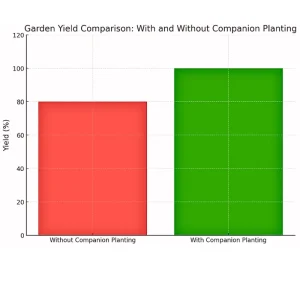
Companion planting is an age-old gardening practice that involves strategically pairing plants to enhance growth, deter pests, and maximize space.
For example, plants like basil and marigolds work synergistically with tomatoes to protect against pests. Furthermore, this approach makes the most of every square inch of limited space.
For a deeper dive into specific combinations, explore these 7 favorite companion planting combinations from gardening experts.
Certain plants work synergistically, sharing nutrients, warding off harmful insects, and even improving soil health. For those working with limited garden areas, this approach is especially powerful. Use vertical gardening to pair plants effectively and save space.
Companion planting for small gardens is particularly effective, as it allows you to pair plants with complementary root systems, improving soil health while saving valuable space.
Benefits of Companion Planting for Small Gardens
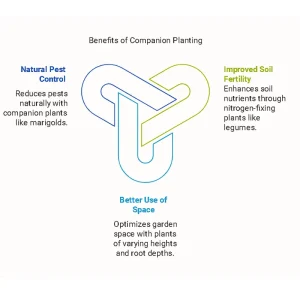
Natural pest control without chemicals. For instance, planting marigolds alongside vegetables can repel aphids and nematodes, reducing the need for synthetic pesticides.
Improved soil fertility through nitrogen-fixing plants. For example, legumes like beans enrich the soil with nitrogen, which benefits heavy-feeding crops such as corn.
Better use of space, with plants of varying heights and root depths. A combination like lettuce and carrots uses both surface and subsurface layers of the soil efficiently, maximizing small garden spaces.
Top Companion Planting Combinations for Small Gardens
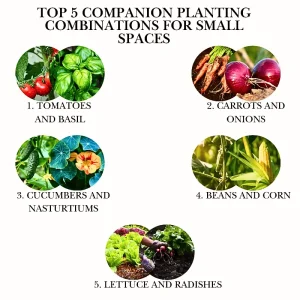
Tomatoes and Basil
Not only do these two make a great pairing on your plate, but they also complement each other in the garden. Basil can deter pests like whiteflies and aphids, ensuring healthier tomato plants. Planting basil close to tomatoes also improves their flavor—a win-win for any gardener. Basil’s aromatic presence also discourages mosquitoes, making the garden a pleasant place to work.
Carrots and Onions
Carrots and onions work together beautifully because their root systems don’t compete. Onions naturally repel carrot flies, making this duo perfect for pest control. This combination allows you to make full use of underground and above-ground space while reducing the risks of pest infestations.
Cucumbers and Nasturtiums
Cucumbers can benefit greatly from companion flowers like nasturtiums. These flowers attract pollinators and repel pests like aphids and cucumber beetles. Additionally, nasturtiums create a colorful, cascading ground cover that helps retain soil moisture and suppress weeds.
Their vibrant colors also enhance the visual appeal of a garden, making it a delightful space for gardeners and visitors alike. Cucumbers can benefit greatly from companion flowers like nasturtiums. These flowers attract pollinators and repel pests like aphids and cucumber beetles.
Additionally, nasturtiums create a colorful, cascading ground cover that helps retain soil moisture and suppress weeds.
Beans and Corn (with Squash: Nature’s Trio for Ultimate Harmony)
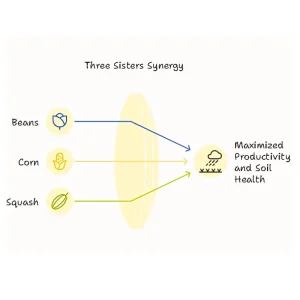
This classic combination, inspired by Native American agriculture, takes advantage of each plant’s growth habits. Beans fix nitrogen in the soil, feeding the corn, while corn provides a natural trellis for climbing bean vines. Adding squash creates a “Three Sisters” planting arrangement that maximizes productivity and soil health.
Lettuce and Radishes
Quick-growing radishes can help loosen the soil for lettuce roots. They also serve as a sacrificial crop, drawing pests away from the more delicate lettuce leaves. Radishes’ flowers can attract beneficial insects, ensuring a thriving ecosystem.
Companion Flowers for Small Gardens
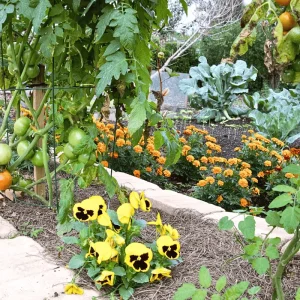
Flowers aren’t just for aesthetics. They also play a critical role in creating a balanced garden ecosystem. By including companion flowers in companion planting for small gardens, you attract pollinators and beneficial insects, boosting vegetable yields.
They also play a critical role in creating a balanced garden ecosystem. By attracting pollinators and beneficial insects, flowers help boost vegetable yields and protect crops from harmful pests.
Best Companion Flowers for Small Gardens
Marigolds: Repel nematodes and deter aphids. Marigolds also release compounds that discourage whiteflies. (picture above marigolds and tomatoes in companion planting set up)
Calendula: Attract beneficial insects like ladybugs and lacewings that keep pests in check. Calendula’s edible flowers are a bonus for your salads.
Sunflowers: Act as a trap crop for aphids, sparing nearby vegetables. Sunflowers also provide shade for heat-sensitive plants like lettuce.
Lavender: A versatile herb that attracts pollinators and repels pests like moths and fleas.
Companion Planting Tips to Maximize Your Garden Space
Plan with a Companion Planting Chart
A detailed companion planting chart for small gardens can help you make informed decisions about what to plant together. Use these charts to identify beneficial combinations and avoid those that can be harmful.
Additionally, customizing your chart based on your specific climate will yield better results. Combine companion planting with seasonal plans for even better harvests.
Utilize Vertical Growing Techniques
Maximize space by using trellises or vertical structures for climbing plants like beans, peas, or cucumbers. Learn how vertical gardening and small space solutions can make a difference with this resource on companion planting in small spaces.
This leaves ground space for smaller crops such as lettuce or herbs. Moreover, hanging baskets for strawberries or herbs further expand planting areas.
Practice Integrated Pest Management (IPM)
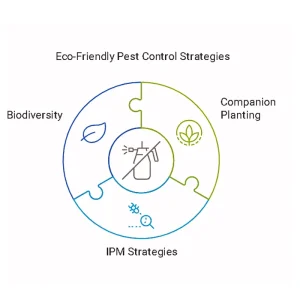
By combining companion planting for small gardens with IPM strategies, you reduce the reliance on chemical pesticides. This involves monitoring pest populations and employing natural deterrents, such as introducing beneficial insects or using companion plants to repel pests.
Furthermore, encourage biodiversity to create a balanced ecosystem..
Utilize Intercropping Methods
Intercropping, or planting different crops close together, can enhance pest control, improve pollination, and optimize space.
For example, pairing root crops like carrots with leafy greens ensures efficient use of soil layers and light. This method also reduces the chances of soil erosion and nutrient depletion.
Incorporate Pollinator-Friendly
Plants Including flowers and herbs that attract bees and butterflies ensures better pollination for fruiting plants like tomatoes and cucumbers.
Plants like lavender, borage, and dill are excellent choices. Additionally, pollinator-friendly plants ensure consistent yields in small gardens.
Rotate Crops Annually

Companion planting works best when combined with crop rotation. This prevents soil depletion and reduces the risk of pests targeting the same plants every year. Diversify your planting plan annually.
Incorporate herbs like parsley, dill, and cilantro not only enhance your meals but also attract pollinators and beneficial insects. Adding herbs like thyme and oregano provides low-growing ground cover that can help deter pests.
Personal Lessons from Companion Planting
My first experience with companion planting for small gardens was in a compact urban garden where space was scarce. It was great to see whiteflies getting confused and at times repelled, while otherwise they would be happily feast on my tomatoes (if it was planted alone).
By pairing basil with my tomatoes and interspersing marigolds among the vegetables, I noticed a significant drop in pests and a boost in yield. Over time, I learned to adapt combinations based on seasonal changes, experimenting with intercropping lettuce and radishes or adding pollinator-friendly plants like calendula.
These small adjustments taught me that a well-planned garden can thrive regardless of size, climate, or soil quality.
Take the First Step Towards a Thriving Garden
If you’re eager to transform your small space into a thriving garden, start with companion planting for small gardens. Download a companion planting chart, experiment with different combinations, and watch your garden flourish.
Remember, every square inch counts, and with thoughtful planning, your garden will too. Share your journey and insights with fellow gardeners, and together, we can cultivate a community that thrives on innovation and nature’s wisdom.
For more insights on natural pest control, urban agriculture technology, and regenerative gardening practices, follow my blog and subscribe to our newsletter for tips and updates.







